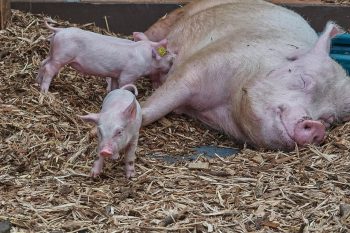Animal Talk Posted by Bjørn A. Bojesen on Jun 24, 2018 in Vocabulary
Hunden er menneskets bedste ven (the dog is man’s best friend), the saying goes. Some would disagree and pick katten (the cat), or maybe even skildpadden (the turtle), guldfisken (the gold fish) or kanariefuglen (the canary), if you’re that kind of person! Either way, dyr (animals) are fascinating – and you need words to discuss them with your fellow humans. Here is a selection of tamme og vilde dyr (tame and wild animals) in Denmark:
- gris/e (pig/s). Some say there are more grise in the country than Danes, which makes sense since Denmark exports a lot of bacon. The male pig is an orne, while the female one is called a so – søer in the plural. (Funnily, søer also means ”lakes”, but I guess there’s no situation where you could possibly confuse the two!) BTW, happy pigs are said to have krølle på halen (a curly tail).
- køer (cows – ko in the singular) are hugely popular, and can be seen lots of places in the countryside. Check out the wild gallop the cows do when they’re let loose in spring! 🙂 A male cow is a tyr and a young one is a kalv.
- får (sheep) are far more common in Færøerne (the Faroe Islands – associated with Denmark). Still, their uld [ull] is essential for all those hipster sweaters! The male sheep is a vædder. A Danish children song goes: Mæ, bæ hvide lam, har du noget uld? (Baa, baa white lamb, have you any wool?)
- ræven (the fox) sometimes takes your høne, hane, kylling (hen, rooster, chicken) or kanin [caNEEN] (rabbit). Most of the time, though, it mostly eats garbage.
- ulven (the wolf) recently returned to Denmark. Hate it or love it – in any case you’ll have to be extremely lucky to catch a glimpse of one of the few Danish ulve!
- egern, ugle, pindsvin, grævling, rådyr, hjort (squirrel, owl, hedgehog, badger, roe, deer). The Danish wilderness is full of beasts stranger than Pokemons. Watch out for the quick-running fasaner (pheasants)!
- a hest (horse) is either a hoppe (mare), a hingst (stallion) or a føl (foal).
- last but not least – hunde get hvalpe (puppies); katte get killinger (kittens)…

Keep learning Danish with us!
Build vocabulary, practice pronunciation, and more with Transparent Language Online. Available anytime, anywhere, on any device.





Comments:
Jo Alex SG:
Tak skal du have for det! I´ve just learned about this blog and have already become a fan! Jeg elsker Dansk but I still understand the spoken language too little and fear I speak it even less, lol.
I’ve heard the Animalist Cause is strong in Denmark and so is the Ecological movement and this has made me love Denmark even more, being an animalist myself and also a supporter of the Ecological Cause.
Bjørn A. Bojesen:
@Jo Alex SG @Jo Alex ‑ I’m so glad you enjoy the blog! 🙂 It’s comments like these that really ”fuel” the posts… Yes, the movement for animal rights is relatively strong in Denmark. There are quite many vegetarians here, and environmental associations such as ”Dansk Naturfredningsforening” also have a lot of members. Maybe it’s because the city of Copenhagen dominates Denmark so much – lots of ”alternativism” in that city. 🙂